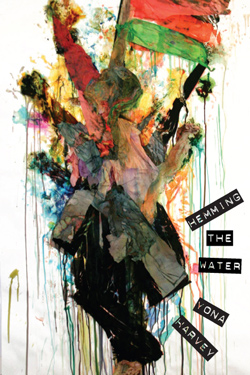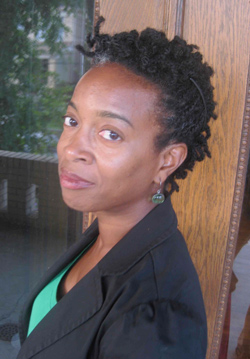
First Book Questionnaire: Yona Harvey | December 7, 2012.
1. Does your manuscript bear any relation to a graduate thesis project?
I haven’t read any graduate thesis projects for many years, so I’m not sure what they look like now! My manuscript looks nothing like my own graduate thesis, though. Back then, I don’t think I was equipped to stand by the things I was drawn to, to the things I’m doing now (multiple voices in one poem, collage, nonlinear narration).
2. How do you feel about these poems now that they’ve materialized in book format?
It’s weird. The poems feel so old! It’s hard to get excited by them—I sometimes cringe when someone says: “I can’t wait to read your book when it comes out.” Of course that’s flattering, but it’s also stress-inducing. I’m like, really, you want to read my book? What on earth for? One of my favorite exercises when I’m feeling down about writing is to go back and look at a random poem in the manuscript. I try to be gentle with myself, even if I think the poem has failed. I think: OK, I can get behind that voice, that former self. I see what she was trying to do. That’s pretty comforting.
3. What was your experience when you began publishing? What challenges did you encounter?
Honestly, my publishing experience was incredibly positive—mostly because I was so clueless about the process. I didn’t even know there was a process. So, in a way, I couldn’t be disappointed. The first poem I ever published was in Natasha Tarpley’s anthology, Testimony. A friend in college (undergraduate) submitted my poem without telling me. Howard University was such a supportive space for young wannabe writers. Sam Hamod, Ethelbert Miller, Brian Gilmore, Toni Asante Lightfoot—all these writers in DC would just take us under their wings. Feed us. Read our work with complete seriousness. It was a really supportive space.
4. How, if at all, did chapbooks prepare you for the making of a full-length collection?
I was very late to the game when it came to chapbooks. They didn’t really influence the first book at all. My friend Douglas Kearney was the one who sold me on them, though. He’s such a talented graphic designer and poet, and smart as hell. He uses chapbooks all the time as a way of setting goals for finishing a set of poems—at least, that’s how I understand what he’s doing. He’d probably explain it a bit more articulately! Anyway, he designed my first chapbook, [Zodiac Suite], and got me to take it seriously. My life is so freaking chaotic, so it’s hard to focus on projects like that sometimes. And psychologically, I think I rebel against the order of a chapbook. Or, maybe, just “order” in general? The demands of parenting, teaching, and loving other human beings require an order in my life that I kind of enjoy abandoning when I write, when I’m in an imaginative space. In the imaginative space, I walk really slowly, my thoughts drag out for hours, and, somehow, everything’s right on time. It’s gonna take me ten years to write another book! That said, I’m looking at some poems now as part of a unit. I have a set called “Performance Perms” that feature dynamic women, their dynamic hair, and their dynamic defiances. Fun.
5. How did you shape and order your manuscript?
As you may have suspected from the previous answer, this was super-difficult for me. That manuscript was written, scrapped, revised, and set aside for over ten years. It was insanity. My concept of time is totally distorted, so I repeatedly failed at ordering the manuscript in a kind of beginning-middle-end format. Finally, as I came to understand myself, my thoughts, and what I valued, I was able to order the manuscript—through colors, sounds, ideas. Mary Lou Williams was my anchor. I asked myself why she was my anchor. Then—bam. After passing the manuscript around among friends—foolishly hoping someone would magically reveal the order to me—it felt good to finally take ownership of the damn thing.
6. Was anyone or anything indispensable in the process of making your debut collection?
My husband and children, my dog (seriously), and my dear friend Douglas Kearney. What a team. How many times does Diana Ross toss off a wig in Lady Sings the Blues? We are who we are when our wigs are off (no eyelashes, no foundation, no lipstick). My thoughts are so lucid and free-flowing when the people I trust are around. Doug is a killer reader. My husband is a killer listener, debater. My kids and their dog—they’re just so full of humor and joy—are totally uncensored. Wow. So these people really helped me to think and speak without any barriers. My scalp was totally aerated.
7. What is your impression of book contests?
They’re fantastic for the people who win them, puzzling for the people who don’t.
8. How did you learn to navigate the press world?
I’m not sure I ever did. Clearly there’s a learning curve, and I’m way behind. Maybe now’s a good time to give a shout out to Carol Muske-Dukes and Sally Ball? Carol has been in my corner for so long—it’s ridiculous. She tried for years to get my manuscript published. And we met in Provincetown when my daughter was about one and a half or two. She had no idea who I was, she didn’t know my husband (who’s also a poet). I mean, she had absolutely nothing to gain by helping me. The attention she gave me was just baffling. And as the manuscript was rejected by various contests or presses over the years, I thought: okay, Carol sees something here. And so did other friends. So having people in my corner helped a lot. And I just kept living my life and not really obsessing about contests or publishing. I’d submit the manuscript for a couple years in a row, then not. And, in the meantime, I was just growing up, building my confidence, learning the rhythms of my body, honoring my feelings, reading. My world—my values, my friends, my aesthetic choices, my family—was just larger than the press world. And that seemed healthy and right for me. I hope that doesn’t sound self-absorbed! I’m just trying to say (longwindedly, sorry): at no point did I feel the need to adjust who I was to fit some perception of the press world, which probably would have been off anyway. And, in the end, I was “discovered” by Sally Ball. She read one of my poems in Rattle and contacted me to see if I had a manuscript. How insane is that? Both Sally and Carol fit the world of art and poetry as I choose to live in it: generously, patiently, supportively, unselfishly, serendipitously. On my own terms.
9. What aspirations did you have for this book?
I hoped a bookish black girl from the Midwest might read it and see herself in it.
10. How would you describe this work?
Curious, troubled, haunted, loving.
11. Do you work primarily on discrete poems, serially, toward a project, with a set of concerns, or otherwise?
One thought at a time. One line. One poem. Always with a set of concerns. I’m suspicious of everyone—even my own children, even myself.
12. Whose poems affect you or your work?
Wow. How much time you got? Terrance Hayes (poems + code of ethics + discipline), Toi Derricotte, Cornelius Eady, Yusef Komunyakaa (we were walking in Provincetown one evening and he said—out of no where: “You should write a poem about Mary Lou Williams.” I think that’s the most Yusef Komunyakaa has ever said to me. So, I said to him: “Okay.” Then thought to myself: I’ve got to find out more about Mary Lou Williams! At the time, all I had was his poem, “My Father’s Love Letters.” That was 1996. And I’ve been infatuated with MLW ever since. I’ll probably be writing about her until I die, until I get it right), Tracie Morris and Thomas Sayers Ellis (transformed the entire way I think about sound and silences in poetry), Joel Dias Porter's Landscape Poems, Rae Armantrout, Elizabeth Bishop, Elizabeth Alexander, Brian Gilmore, Kathleen Peirce, Kathy Fagan, Claudia Rankine, Emily Dickinson, R. Erica Doyle, Erica Hunt. I think non-poets affect my work most, though. Virginia Hamilton, Jamaica Kincaid, Sterling Brown, and Toni Morrison. Too many musicians, visual artists, and graphic/comic illustrators/writers to name. They help me step outside myself. I view their work or read their interviews and certain obstacles in poetry are overcome, simply because I’m thinking about the process differently.
13. What are you working on now?
I’ve been in a little woodshed at the edges of the poetry forest for so long (I’m resisting the word “bubble”), so I’m actively focused on more collaborations. There’s this whole new generation of young poets who are organizing events and writing poems in fresh ways. And they’re not passive with their thinking. They respect the old heads, but they don’t blindly worship them, they’re kind of bold and kick-ass. That’s cool. And that advances black poetry (all poetry) in a good way. I hope this book puts me in contact with them more, enables me to travel, to keep a healthy, artistic momentum going. More specifically, I have these little short prose pieces for collaboration with a visual artist here in Pittsburgh, Vanessa German. Collaborating is really difficult! Last summer when I expressed my anxieties over the collaborative process to the visual artist, Michelle Tillander, she challenged me with this idea: in a true collaboration, both artists are together making something they wouldn’t make on their own. I’m still thinking on that.
